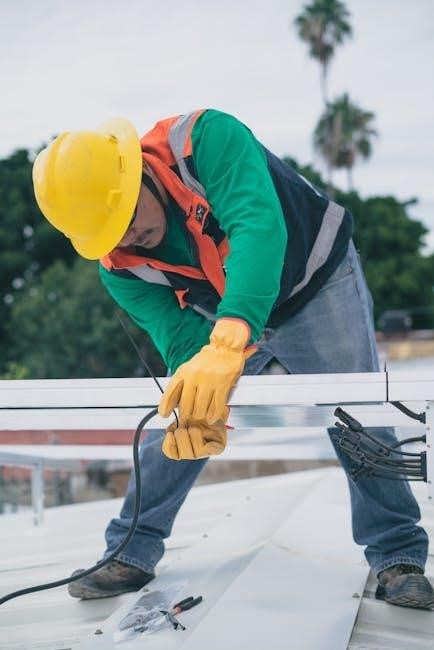xnx xnx transmitter installation manual

The XNX Universal Transmitter is designed for global hazardous area use. This guide provides a quick reference for installation‚ operation‚ and maintenance. Comprehensive documents are available on the Honeywell Resource CD‚ ensuring proper commissioning and setup.
Overview of the XNX Universal Transmitter
The XNX Universal Transmitter stands as a versatile solution‚ engineered and certified for deployment in hazardous environments across the globe. Its adaptability shines through various sensing technologies‚ seamlessly accommodating both local and remote sensor attachments with appropriate accessories. Five threaded ports‚ available in metric or NPT versions‚ offer ultimate installation flexibility‚ ensuring compatibility with diverse setups. The transmitter’s modular design supports a wide array of sensors on a common platform‚ providing a cost-effective solution with a choice of inputs and outputs. Users can efficiently configure range‚ alarm levels‚ and other parameters to tailor the transmitter to specific application needs;
Safety Precautions Before Installation
Prior to installation‚ operation‚ or maintenance‚ thoroughly read and understand the manual. Pay close attention to warnings and cautions. Installation must adhere to recognized standards of the relevant authority.
Warnings and Cautions in the Manual
Before initiating any installation‚ operation‚ or maintenance procedures on the XNX Universal Transmitter‚ it is imperative to thoroughly review and comprehend the entirety of the manual. Special attention must be directed towards all delineated warnings and cautions‚ as these highlight critical safety measures necessary to mitigate potential hazards. These warnings address potential risks associated with improper handling‚ electrical connections‚ and environmental conditions. Ignoring these precautions could result in equipment damage‚ personal injury‚ or even fatal consequences. Ensure that all personnel involved in the installation process are adequately trained and aware of these safety protocols. Adherence to these guidelines is paramount for a safe and efficient deployment of the XNX Universal Transmitter.

Mounting the XNX Transmitter
The XNX Transmitter offers flexible mounting through integral tabs. These tabs allow attachment to flat surfaces. Proper mounting ensures stability and optimal performance in diverse installation environments‚ per the manual.
Methods Using Integral Mounting Tabs
The XNX Universal Transmitter features integral mounting tabs for versatile installation; These tabs enable secure attachment to flat wall surfaces‚ providing a straightforward mounting solution. The transmitter can also be fixed to horizontal or vertical pipe structures using a U-bolt and pipe mounting bracket‚ accommodating Ø100-150mm (Ø4 to 6) pipes. This method ensures stability in various industrial settings; The mounting lugs on the transmitter body facilitate direct surface mounting. Proper mounting is crucial for optimal performance and safety. These methods offer flexibility in deploying the XNX Transmitter in diverse environments. Always refer to the manual for detailed installation instructions and safety guidelines.
Wiring the XNX Transmitter
Before wiring‚ verify the correct personality boards and options are installed. Proper operation requires careful attention to wiring details as described in the XNX Transmitter installation manual for safety and functionality.
General Wiring Considerations
Before initiating any wiring procedures on the XNX Transmitter‚ it is crucial to confirm the correct personality boards and option modules are properly installed. Ensuring compatibility between the transmitter and connected devices is paramount for optimal performance and safety. Always consult the detailed wiring diagrams and specifications outlined in the XNX Universal Transmitter installation manual‚ paying close attention to polarity and voltage requirements.
Incorrect wiring can lead to malfunctions‚ damage to equipment‚ or even hazardous situations. Therefore‚ meticulous adherence to the manual‘s guidelines is essential. Furthermore‚ verify that all connections are secure and properly insulated to prevent short circuits or signal interference. Prioritize safety by disconnecting power before commencing any wiring tasks.

Sensor Installation
For proper gas detection‚ install the sensor following the provided instructions. A missing oxygen cell can cause a zero reading. Connect the IS Barrier to the appropriate ports as indicated for electrochemical sensors.
Electrochemical Sensor Installation
When installing electrochemical sensors in the XNX Universal Transmitter‚ ensure proper connections to maintain accurate gas detection. A critical step is connecting the optional Local HART IS Barrier to J1 for sensor communication‚ or connecting the EC IS Barrier to J2. Note that a missing oxygen cell results in a 0 V/V O2 gas concentration reading‚ potentially causing false alarms or a failure to detect hazardous conditions.
Refer to the manual for specific warnings and cautions regarding hazardous area installation requirements‚ ensuring compliance with local regulations and safety standards. Prior to installation‚ verify that the correct personality boards and options are installed within the XNX Universal Transmitter‚ as this influences the wiring configurations. Proper grounding and shielding are crucial for minimizing electrical noise and maintaining signal integrity. Always use appropriate tools and personal protective equipment when handling sensors and wiring components.

Configuring the XNX Transmitter
After sensor installation‚ confirm the gas type. Next‚ set the desired range‚ alarm levels‚ and other parameters within the XNX transmitter’s configuration menu. Finally‚ calibrate the transmitter by following the prescribed calibration procedures outlined in this manual.
Setting Range‚ Alarm Levels‚ etc.
After completing the electrochemical sensor installation‚ it is crucial to configure the XNX transmitter appropriately. The first step involves confirming the specific gas type that the sensor is designed to detect. Following this‚ you must set the desired measurement range to ensure accurate readings within the expected operating conditions. Subsequently‚ carefully define the alarm levels‚ including warning and alarm thresholds‚ according to your safety requirements.
These settings determine when the transmitter triggers alerts based on detected gas concentrations. Finally‚ calibrate the transmitter by adhering to the recommended calibration procedures outlined in the installation manual. Proper configuration guarantees the XNX transmitter functions effectively in detecting and reporting gas hazards.
Power Supply Considerations
For single transmitter setups‚ power should range from 16 to 32 VDC‚ but this depends on the sensor. A single XNX transmitter installation per power source offers maximum isolation for critical monitoring applications.
Single Transmitter Installation per Power Source
A single XNX transmitter installation utilizes a dedicated power source for each unit‚ maximizing isolation and minimizing potential interference between devices. This configuration enhances system reliability‚ particularly in critical applications where uninterrupted monitoring is essential. Implementing a dedicated power supply for each transmitter ensures that a failure in one unit’s power circuit does not affect the operation of other transmitters within the system. This approach provides a robust and dependable solution for maintaining accurate and continuous gas detection‚ especially in hazardous environments where safety is paramount. Proper planning and execution of power distribution are crucial for optimal system performance and safety compliance. This setup simplifies troubleshooting and maintenance‚ as each transmitter operates independently‚ reducing downtime and ensuring consistent data integrity.
Maintenance of the XNX Transmitter
Regular maintenance is crucial for ensuring the XNX Transmitter’s optimal performance and longevity. Routine checks should include inspecting for corrosion‚ verifying sensor integrity‚ and confirming proper wiring connections. Calibration is a critical aspect of maintenance‚ ensuring accurate gas detection. Replace any worn or damaged components promptly to prevent system failures. Keep the transmitter housing clean and free from debris that could impede its functionality. Regularly review fault and warning logs to identify potential issues before they escalate. Proper documentation of all maintenance activities is essential for tracking performance trends and ensuring compliance. Adhering to a strict maintenance schedule minimizes downtime and maximizes the reliability of the XNX Transmitter in critical safety applications. Utilizing anti-seize compound on threads prevents corrosion buildup‚ further extending the equipment’s lifespan and ensuring ease of future maintenance tasks.

Troubleshooting Common Issues
Addressing common issues promptly is vital for maintaining the XNX Transmitter’s reliability. Fault 152 often indicates a configuration problem after installing a new option board; ensure the XNX recognizes the new hardware. Investigate wiring connections for any looseness or damage if experiencing erratic readings. Check sensor health and replace if nearing the end of its lifespan. Verify power supply voltage is within the specified range (16-32 VDC). Examine the display for error messages‚ consulting the manual for troubleshooting steps. Confirm the correct gas type and range are configured. Recalibrate the transmitter if readings are inaccurate. Inspect the housing for damage that could affect performance. Use the device descriptor files for proper communication. Regularly monitor the transmitter’s operation to identify and resolve issues quickly.





